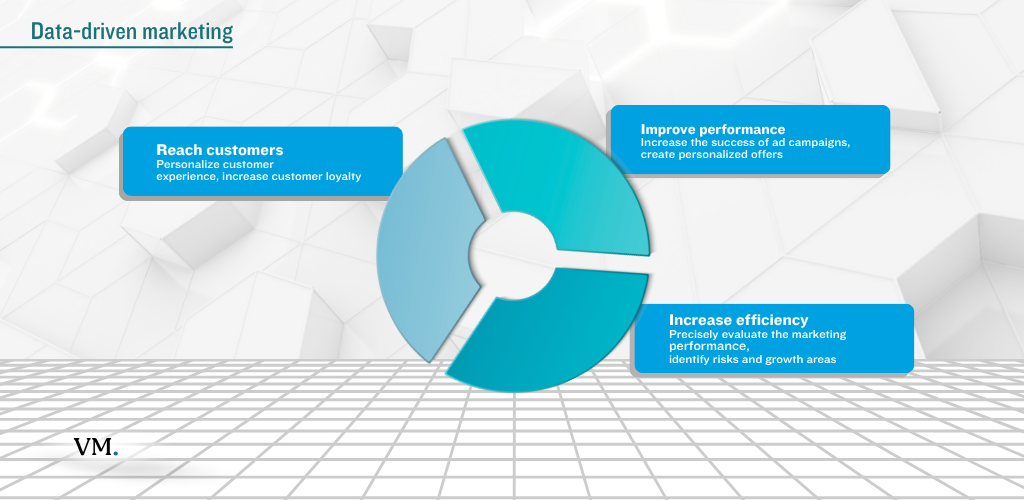Let’s explore these 7 data-driven marketing trends.
As we step into 2025, the marketing landscape is evolving at an unprecedented pace. Are you prepared to adapt and thrive in this changing environment? With consumer expectations shifting and technology advancing rapidly, businesses must stay ahead of emerging trends to remain competitive.
7 Data-Driven Marketing Trends To Remember And Use This Year
Data-driven marketing is no longer just a buzzword; it’s a necessity for success. By leveraging data, you can make informed decisions that resonate with your audience and drive meaningful results. Imagine being able to anticipate customer needs, personalize experiences, and optimize your campaigns in real-time—all while building stronger connections with your audience.
In this blog post, we will explore seven crucial data-driven marketing trends that you cannot afford to ignore in 2025. These insights will empower you to future-proof your marketing strategy and ensure your business thrives in the years to come.

Trend 1: AI-Powered Personalization
Artificial intelligence (AI) is revolutionizing how businesses engage with their customers. In 2025, AI will continue to enhance personalization by enabling hyper-targeted content delivery based on user behavior.
This trend will allow marketers to automate customer interactions through advanced chatbots and virtual assistants while optimizing campaigns in real-time for better ROI.
- How to Implement It: Invest in AI-driven tools such as predictive analytics platforms or personalized email marketing solutions. Use these tools to segment your audience effectively and craft unique experiences that resonate with each group.
- Remember, while AI can streamline processes, the human touch remains irreplaceable in building genuine relationships.
Trend 2: Voice Search Optimization
With the increasing prevalence of smart speakers and voice-activated devices, voice search is becoming a dominant force in how consumers find information online. To stay relevant, businesses must adapt their SEO strategies to include voice search optimization.
- What to Focus On:
- Optimize for conversational keywords and long-tail phrases.
- Ensure your website’s loading speed is fast and mobile-friendly.
- Create content that answers common questions clearly and concisely.
SEO Statistics for 2025: Key Insights for Marketers
| Category | Statistic | Source | Implication |
|---|---|---|---|
| Market Growth | Global SEO market to reach $143.9 billion by 2030 (CAGR of 8.3% from 2023) | Exploding Topics | Continued investment in SEO is warranted; the market shows no signs of slowing down. |
| Market Growth - Mobile | Mobile SEO market is expected to grow at a 10.0% CAGR by 2030. | Exploding Topics | Mobile-first indexing is CRITICAL. Optimize EVERYTHING for mobile. |
| Organic Traffic Value | 53.3% of all website traffic comes from organic searches. | Intergrowth | Organic search remains a dominant traffic source, emphasizing the importance of SEO for website visibility. |
| Search Engine Dominance | Google holds 92.58% of the total search engine market share. | Intergrowth | Focus SEO efforts primarily on Google, but don't completely ignore Bing, Yahoo, etc. |
| Mobile Usage | By 2025, 72.6% of internet users will exclusively use a mobile device to access the web. | Intergrowth | Website MUST be mobile-friendly. |
| Zero-Click Searches | 69% of clicks go to the top five websites in search engine results. | SMA Marketing | Need to be on top 5, and consider rich snippets and features for increased real-estate. |
| Keyword Behavior | 95% of keywords are searched fewer than 10 times monthly. | Intergrowth | Focus on long-tail keywords and niche topics to capture targeted traffic. |
| New Queries | 15% of all search queries have never been searched before. | SMA Marketing | Stay updated on trends and create content that answers emerging questions. |
Trend 3: The Rise of the Creator Economy
Creators and influencers are playing an increasingly significant role in marketing as brands shift towards more authentic and relatable forms of content. Partnering with the right creators can help businesses build trust within their target audience and reach niche communities through platforms like TikTok, YouTube, and Instagram.
- Pro Tip: Focus on micro and nano-influencers who have highly engaged followers. Their smaller but dedicated audiences often lead to better conversion rates.
Trend 4: Sustainability as a Core Value
Consumers are more environmentally conscious than ever before. In 2025, they expect brands to prioritize sustainability and align with their values. This shift affects not only product development but also marketing strategies.
- How to Align Your Marketing:
- Showcase eco-friendly practices and certifications.
- Share behind-the-scenes stories about how your business is reducing its environmental footprint.
- Use sustainable packaging for your products and highlight it in your campaigns.
Trend 5: Immersive Marketing with AR and VR
Augmented reality (AR) and virtual reality (VR) are transforming how brands engage with their audiences. From virtual try-ons to immersive brand experiences, these technologies offer endless possibilities for capturing attention.
- Ways to Use AR/VR in Marketing:
- Create virtual product demos or store experiences.
- Offer interactive AR filters on social media platforms.
- Develop VR training programs or experiences showcasing your brand’s expertise.
Trend 6: Data Privacy Prioritization
As data privacy concerns continue to rise, businesses must prioritize compliance while building trust with their customers. In 2025, effective data management will be crucial for maintaining customer loyalty.
- Strategies for Protecting Customer Data:
- Implement transparent data collection practices.
- Ensure compliance with regulations like GDPR and CCPA.
- Communicate your commitment to data privacy clearly in your marketing efforts.
Trend 7: The Simplification Imperative
Complexity is the enemy of conversion. In 2025, business decision-makers will gravitate toward brands that offer clarity, speed, and autonomy throughout the buying process.
- What to Do: Streamline buyer journeys with self-service options, intuitive tools, and transparent insights. Eliminate unnecessary steps and empower buyers to move at their own pace. For example, a SaaS company introduced an interactive pricing calculator that reduced sales cycles by 15%.
- Topical Authority: Google increasingly rewards sites that demonstrate deep, interconnected expertise on a subject.
- Semantic Search: Clusters and pillars together help Google’s AI understand your site’s context and relevance, especially as zero-click and voice searches rise.
- User Intent: Modern SEO is about answering users’ questions comprehensively and intuitively- something the cluster-pillar model excels at.
The Numbers Behind Data-Driven Marketing
Market Growth and Adoption
The data-driven marketing sector continues to experience remarkable growth. According to recent industry reports, global spending on data analytics solutions for marketing reached $98.4 billion in 2024, with projections indicating a 14.2% compound annual growth rate through 2028. Notably, 67% of marketing leaders now allocate at least one-quarter of their budgets to data-driven initiatives—a significant increase from 42% just three years ago.
Personalization and Customer Experience
Personalization remains a cornerstone of effective marketing strategies:
- 72% of consumers engage only with personalized messaging (Forrester Research, 2024)
- Companies achieving advanced personalization report 40% higher revenue than industry counterparts (McKinsey, 2025)
- Yet only 24% of organizations have achieved the data integration necessary for true omnichannel personalization
The gap between consumer expectations and business capabilities presents both a challenge and an opportunity for marketers willing to invest in robust data infrastructure.
Mobile and Voice Search Trends
The mobile revolution continues to reshape search behavior:
- Mobile devices now account for 68% of all search traffic
- 43% of consumers use voice search daily on their smartphones
- Local businesses receive 29% more inquiries from voice search than traditional text searches
These figures underscore the necessity of optimizing for mobile and voice experiences as standard practice rather than optional enhancements.
Wrapping It Up
These seven data-driven trends are not just passing fads—they’re shaping the future of marketing. By adopting these strategies now, you’ll build stronger connections with your audience, enhance your competitive advantage, and drive better results for your business.
As you prepare for the future of marketing in 2025, remember that staying ahead of these trends is essential for success. Embrace innovation, prioritize customer-centric strategies, and leverage data-driven insights to create a thriving marketing ecosystem.
If you need help navigating these trends or crafting a strategy tailored for your business, don’t hesitate to reach out! Subscribe to Vedran’s email list for more insights on how to future-proof your marketing efforts today!
FAQ
In 2025, key SEO trends include AI-powered personalization, voice search optimization, the rise of the creator economy, sustainability in marketing, immersive marketing with AR and VR, data privacy prioritization, and simplification of user experiences. Staying updated on these trends will help businesses remain competitive.
With an increasing number of users accessing the internet exclusively through mobile devices, mobile optimization is crucial for SEO success. Google uses mobile-first indexing, meaning it primarily considers the mobile version of a website for ranking. A mobile-friendly site enhances user experience and improves search rankings.
AI can be integrated into your SEO strategy through tools that analyze data patterns, automate content creation, and personalize user experiences. For example, AI-driven analytics can help identify which keywords to target based on current trends and user behavior.
Voice search is becoming increasingly popular as more consumers use smart speakers and voice-activated devices. To optimize for voice search, focus on natural language keywords and create content that answers common questions clearly and concisely.
Data privacy is paramount as consumers become more concerned about how their information is used. Businesses must prioritize transparency in data collection practices and ensure compliance with regulations like GDPR and CCPA to build trust with customers.
Long-tail keywords are longer, more specific phrases that users search for when looking for particular information or products. They are important because they often have lower competition and higher conversion rates, making it easier to attract targeted traffic to your website.



